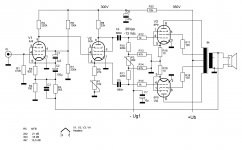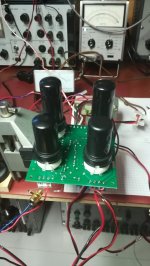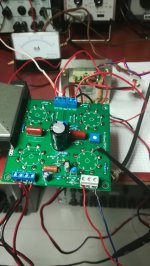Hi,
I've just bought some of these Soviet Valves, attracted by the fairly high gain, or similarity in some aspects, to KT61.
Has anyone here experimented with them?
Any advice/designs/recommendations, that you could share?
TIA,
Greg
I've just bought some of these Soviet Valves, attracted by the fairly high gain, or similarity in some aspects, to KT61.
Has anyone here experimented with them?
Any advice/designs/recommendations, that you could share?
TIA,
Greg
6P9 is the pre-decessor of 6P15P
Similar to EL84, but with denser screen grid.
Very linear in triode mode. Very nice in pentode, but don't exceed G2 voltage rating, better regulate it!
Similar to EL84, but with denser screen grid.
Very linear in triode mode. Very nice in pentode, but don't exceed G2 voltage rating, better regulate it!
Has anyone here experimented with them?
Any advice/designs/recommendations, that you could share?
"Full Metal" 15 W PP-amplifier:
Attachments
artosalo,
Very nice looking amplifier!
I miss those metal tubes that I had in a surplus military airplane shortwave radio that I used to have.
I am guessing that the purpose of the rheostat in the concertina is not to balance the concertina (with equal cathode and plate resistors, the balance is automatic, all the way until the signal level draws concertina tube grid current).
Instead, I am guessing the purpose of the rheostat in the concertina is to null out any
un-balance of the two output tubes.
Right?
“Those who do not know history, do not know the meaning of Deja Vu”
Very nice looking amplifier!
I miss those metal tubes that I had in a surplus military airplane shortwave radio that I used to have.
I am guessing that the purpose of the rheostat in the concertina is not to balance the concertina (with equal cathode and plate resistors, the balance is automatic, all the way until the signal level draws concertina tube grid current).
Instead, I am guessing the purpose of the rheostat in the concertina is to null out any
un-balance of the two output tubes.
Right?
“Those who do not know history, do not know the meaning of Deja Vu”
Last edited:
I was looking at something similar, for a first stab at PP trioded pentode.
I might have to start with SET only, until I get some PP OPTs, but I want to play with adding positive G3 volts, probably using zener diodes.
zener diodes.
That output stage looks ideal for me, as I can easily get 26Vpp from 2 stages of 6N16B, 6N17B, or maybe a more conventional b9a valve.
Thanks! I've seen this before, but wouldn't have found it
I might have to start with SET only, until I get some PP OPTs, but I want to play with adding positive G3 volts, probably using
 zener diodes.
zener diodes.That output stage looks ideal for me, as I can easily get 26Vpp from 2 stages of 6N16B, 6N17B, or maybe a more conventional b9a valve.
Thanks! I've seen this before, but wouldn't have found it
Last edited:
I am guessing the purpose of the rheostat in the concertina is to null out any
un-balance of the two output tubes.
Yes it is. In case of fixed bias, mostly the bias balance should be adjusted more or less.
Then to get the optimum THD, AC-balance must be adjusted as well.
Thanks! I've seen this before, but wouldn't have found it
It was 9 years ago when I built the first prototype of this amplifier.
Then couple years ago I designed the pcb for it.
Distortion spectrum vs feedback
This graph was at the interest then: (THD vs. GNFB)
Attachments
Last edited:
- Home
- Amplifiers
- Tubes / Valves
- 6P9 valve


